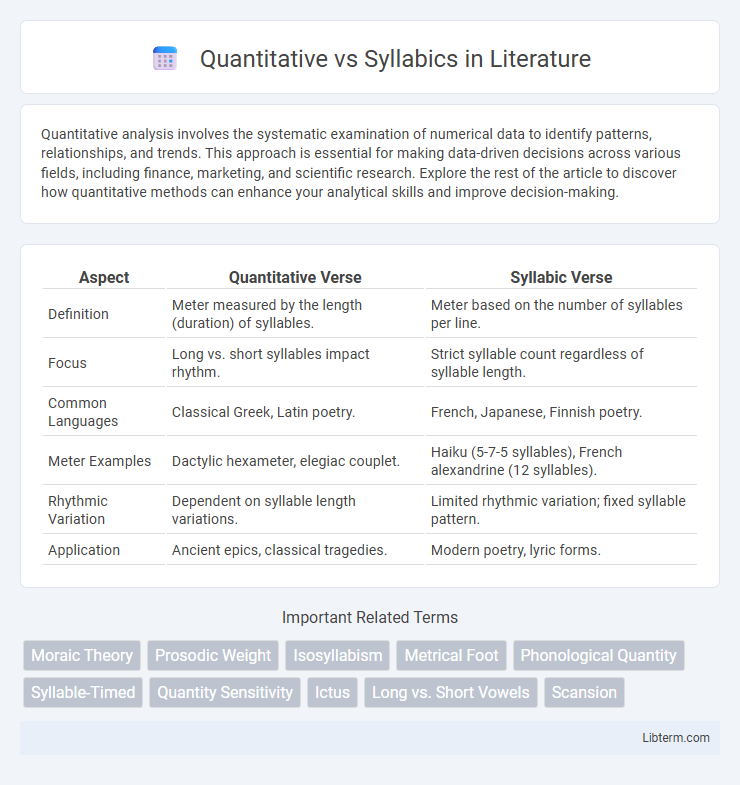Quantitative analysis involves the systematic examination of numerical data to identify patterns, relationships, and trends. This approach is essential for making data-driven decisions across various fields, including finance, marketing, and scientific research. Explore the rest of the article to discover how quantitative methods can enhance your analytical skills and improve decision-making.
Table of Comparison
| Aspect | Quantitative Verse | Syllabic Verse |
|---|---|---|
| Definition | Meter measured by the length (duration) of syllables. | Meter based on the number of syllables per line. |
| Focus | Long vs. short syllables impact rhythm. | Strict syllable count regardless of syllable length. |
| Common Languages | Classical Greek, Latin poetry. | French, Japanese, Finnish poetry. |
| Meter Examples | Dactylic hexameter, elegiac couplet. | Haiku (5-7-5 syllables), French alexandrine (12 syllables). |
| Rhythmic Variation | Dependent on syllable length variations. | Limited rhythmic variation; fixed syllable pattern. |
| Application | Ancient epics, classical tragedies. | Modern poetry, lyric forms. |
Introduction to Quantitative and Syllabic Systems
Quantitative systems measure poetic meter based on the length or duration of syllables, distinguishing between long and short sounds, while syllabic systems rely on a fixed number of syllables per line, regardless of stress or length. Ancient Greek and Latin poetry predominantly use quantitative meters like dactylic hexameter, emphasizing syllable length for rhythmic structure. In contrast, languages such as Japanese and Finnish employ syllabic meters, focusing on syllable count to organize verse without reference to syllable duration.
Historical Origins and Development
Quantitative meter, rooted in ancient Greek and Latin poetry, measures the duration of syllables based on vowel length, emphasizing long and short syllables in complex metrical patterns. Syllabic meter, historically prominent in Romance languages such as French and Spanish, counts the number of syllables per line regardless of stress or length, reflecting a shift from classical prosody to more language-specific rhythms. The development of these systems illustrates the adaptation of poetic structure to linguistic characteristics, influencing the evolution of Western poetic traditions over centuries.
Defining Quantitative Meter
Quantitative meter in poetry measures the duration of syllables based on their length, distinguishing long and short syllables to create rhythm. This contrasts with syllabic meter, which counts the number of syllables regardless of their duration. Classical Latin and Greek poetry predominantly employ quantitative meter, relying on patterns of syllable length to structure verses.
Understanding Syllabic Meter
Syllabic meter organizes poetry based on the number of syllables per line, ignoring stress patterns, whereas quantitative meter depends on the length or duration of syllables. Understanding syllabic meter requires focusing on consistent syllable counts to create rhythm, commonly found in languages like Japanese and Finnish. Unlike stress-based meters, syllabic meter emphasizes syllable quantity over stress or duration, shaping the poem's flow and pacing.
Key Differences Between Quantitative and Syllabic
Quantitative meter measures syllable length by duration, distinguishing between long and short syllables, essential in classical Latin and Greek poetry. Syllabic meter counts only the number of syllables per line, regardless of length, prevalent in languages like French and English. The primary difference lies in quantitative meter's reliance on temporal syllable length versus syllabic meter's focus solely on syllable count.
Cultural and Linguistic Contexts
Quantitative prosody measures syllable length based on vowel duration, a system crucial in Classical Latin and Greek poetry, reflecting the cultures' emphasis on rhythmic precision and oral tradition. Syllabic meter, predominant in languages like Japanese, counts syllables regardless of length, aligning with linguistic structures that favor mora-timed rhythms and compact phonetic units. These distinct prosodic models illustrate how cultural and linguistic contexts shape poetic forms, influencing not only aesthetics but also the transmission and preservation of oral literature.
Examples in Classical Literature
Quantitative meter in classical literature, such as Latin and Ancient Greek poetry, relies on the length of syllables, exemplified by Virgil's use of dactylic hexameter in the "Aeneid." Syllabic meter, predominant in languages like Japanese, counts the number of syllables per line, as seen in the traditional haiku structure with its 5-7-5 syllabic pattern. These distinct metrical systems demonstrate how phonetic emphasis shapes poetic rhythm across different linguistic traditions.
Modern Adaptations and Influences
Modern adaptations of quantitative and syllabic verse systems reveal divergent approaches to rhythm in contemporary poetry. Quantitative metrics, rooted in classical languages, influence modern experimental poetry through the use of vowel length and stress patterns, while syllabics dominate in structured forms like haiku and tanka by emphasizing fixed syllable counts. These influences shape digital poetry algorithms and teaching methodologies, reinforcing the relevance of classical prosody alongside evolving poetic expressions.
Pros and Cons of Each System
Quantitative pros include precise measurement of vowel length, essential for classical languages like Latin and Greek, while its cons involve complexity and less suitability for modern languages with variable stress patterns. Syllabics excel in representing syllable structure intuitively, making them ideal for language acquisition and phonological analysis; however, they may lack the fine granularity to capture vowel length or stress distinctions accurately. Choosing between quantitative and syllabic systems depends on language-specific phonetic needs and analytical goals.
Conclusion: Choosing the Right Meter
Quantitative meter, based on syllable length, suits classical languages like Latin and Greek, emphasizing rhythm through time duration, while syllabic meter relies on a fixed syllable count per line, common in languages with less distinction in syllable length such as English. Selecting the appropriate meter depends on the language's phonetic characteristics and the desired rhythmic effect in poetry. Understanding the strengths of each meter ensures effective poetic expression and preserves the natural flow of the language.
Quantitative Infographic

 libterm.com
libterm.com